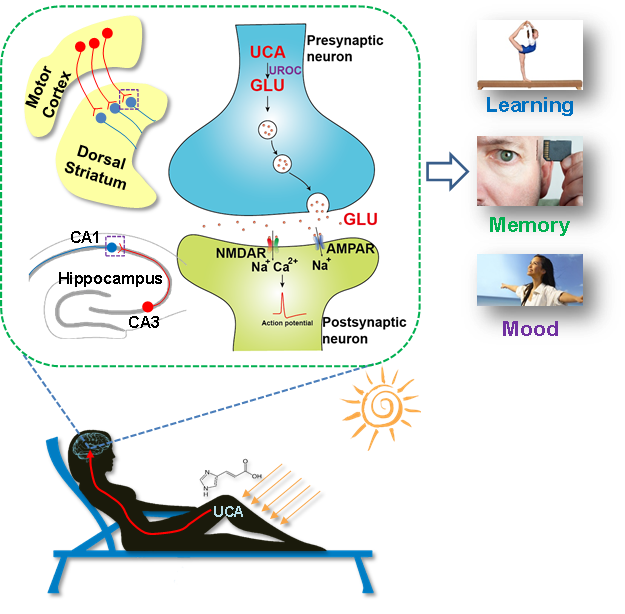USTC Reveals the Mechanism How Moderate Sunlight Exposure Improves Learning and Memory [2018-05-23] USTC researchers have shed new lights on the correlation between sunlight exposure and related neurobehaviors. Combining single-cell mass spectrometry
USTC researchers have shed new lights on the correlation between sunlight exposure and related neurobehaviors. Combining single-cell mass spectrometry and isotopic labeling technique, the multi-institutional team led by Prof. XIONG Wei and Prof. HUANG Guangming uncovered a novel sunlight-activated glutamate biosynthetic pathway in the mouse brain. Such pathway may fundamentally contribute to our daily neurobehaviors such as mood, learning and cognition.
The research article entitled “Moderate UV Exposure Enhances Learning and Memory by Promoting a Novel Glutamate Biosynthetic Pathway in the Brain” is published inCell on May 17th.

The proposed mechanism of how sunlight exposure affects learning, memory and mood / (Image by ZHU Hongying)
According to Professor XIONG Wei from the School of Life Sciences, the ultraviolet (UV) light enhanced learning capacity has been observed on mice. “The mice without UV exposure typically require 6 rounds of training to adapt to the rotating rod,” said Professor XIONG Wei, however for the UV-exposed mice, they become smarter and only require 4 rounds of training.”

Professor XIONG Wei and the researchers (from right to left) (left photo) and the Rotarod mouse-training instrument (right photo) / (Image provided to USTC News Center)
The mechanism is examined using interdisciplinary techniques. It is revealed that the moderate UV exposure elevates the blood urocanic acid (UCA), which is later converted to glutamate (GLU) in the brain cells. The as-synthesized GLU contributes to the enhanced learning capacity of mice. In addition to learning, such UV-triggered GLU synthesis could contribute to more sunlight-induced neurobehavioral changes such as memory and mood.
The project is supported by the National Key R&D Program of China, the National Natural Science Foundation of China, the Strategic Priority Research Program of the Chinese Academy of Sciences, the Fundamental Research Funds for the Central Universities, the Major/Innovative Program of Development Foundation of Hefei Center for Physical Science and Technology and the Recruitment Program of Global Experts.
Back
